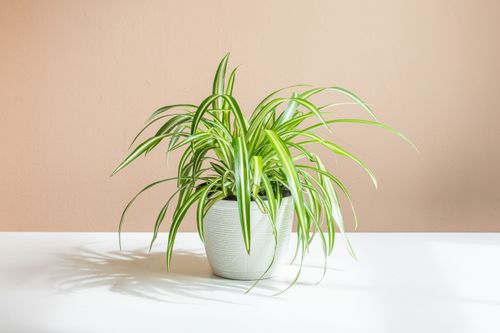Snake plant
| Botanical Name: | Dracaena trifasciata |
| Common Name: | Snake plant, viper's bowstring hemp, St. George's sword, Mother-in-law's tongue |
| Caused by: | |
| Classification: |
| Kingdom | Plantae |
| Phylum | Magnoliophyta |
| Class | Magnoliophyta |
| Order | Asparagales |
| Species | NA |
| Family | Asparagaceae |
| Genus | Dracaena |
| Botanical Name | Dracaena trifasciata |
| Common Names | Snake plant, viper's bowstring hemp, St. George's sword, Mother-in-law's tongue |
| Care | Easy |
| Humidity | Dry - Medium |
| Sun Exposure | Partial Shade |
| Edible Parts | flowers |
| Temperature | 70° and 90° F |
| Height | 6 inches to 8 feet |
| Soil | Sandy, well-drained |
| Growth rate | Slow |
| Life Cycle | Perennial |
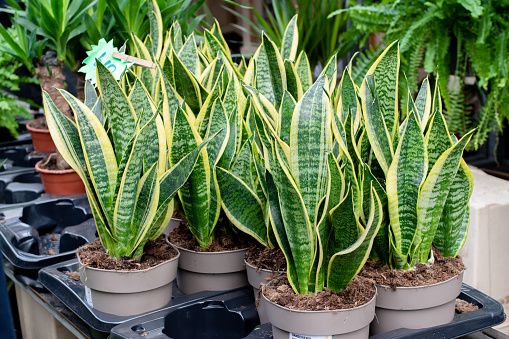
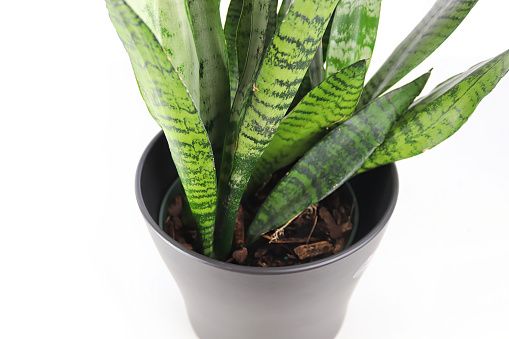

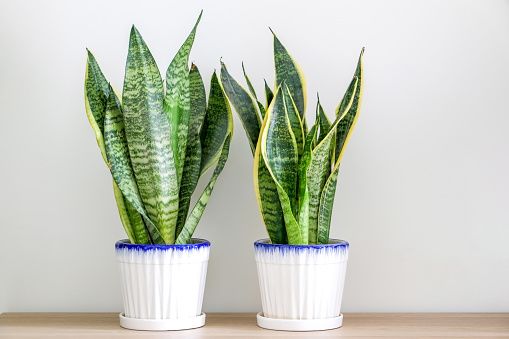
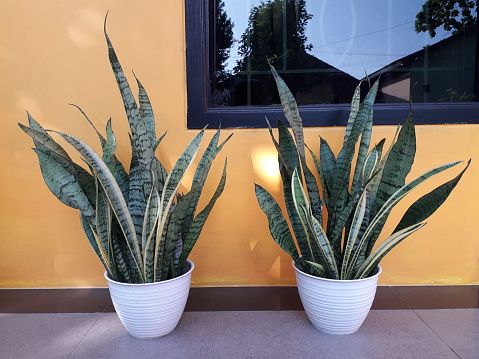
One of the most common and resilient types of houseplants is Dracaena trifasciata, also referred to as the snake plant. It was categorized as Sansevieria trifasciata botanically up until 2017, however there were much too many similarities between it and Dracaena species to ignore. The plant can grow from six inches to eight feet tall and has rigid, sword-like leaves. Although the color of snake plants can vary, many have leaves with green bands and frequently have a yellow border. These plants are simple to grow and frequently practically unbreakable. They will flourish in areas of the house that are nearly dark or in very intense light. In indoor lighting, snake plants typically develop slowly, but adding more light will speed up growth if the plant gets a few hours of direct sunlight. The optimal time to plant and repot is in the spring.
For novice gardeners, a snake plant is a great choice because it is tough to kill. It looks excellent in containers and thrives on the ground or in window boxes. In warm climates, snake plants flourish while they suffer in the cold. Although resistant to drought, this plant can become overwatered, which can cause root rot. 2 A plant should only be watered if the soil feels dry. In the winter, these plants may endure two months without being watered. Water no more frequently than every two weeks during the summer.
Light
Snake plants prefer steady, indirect light that includes some direct sunlight. They can adapt to full sun exposure and can endure low light conditions.
Soil
A loose, well-drained potting mix is preferred by snake plants. Sandier soils are ideal for growing this plant. Use a potting medium with little peat in it. Peat is useful in a variety of applications, however it can get compacted and occasionally has drainage or rehydration issues. A nice option is an all-purpose cactus potting soil.
Water
In between waterings, let the soil to dry. Reduce watering in the winter to once a month or whenever the soil feels dry to the touch. Water your plants sparingly; overwatering might be bad for the plant.
Temperature and Humidity
If exposed to temperatures below 50 degrees Fahrenheit, snake plants will suffer since they like warm surroundings. Place the plant in an area that will shield it from drafts. It is ideal if the temperature is between 70 and 90 degrees Fahrenheit. This plant will die from frost.
Fertilizer
During the growing season, feed your cacti with a moderate cactus fertilizer, a balanced liquid slow-release 10-10-10 fertilizer, or a 20-20-20 fertilizer that has been diluted to half strength. Winter is not the time to fertilize.
- Dracaena trifasciata 'Hahnii': It only reaches a height of around six inches and is also known as the bird's nest snake plant. Its leaf clumps resemble a bird's nest.
- Dracaena angolensi: This cylindrical snake plant, also known as Sansevieria cylindrical, has spherical, rigid leaves that can grow to be several feet long. Outward arcing from a central crown are the leaves.
- Dracaena trifasciata 'Laurentii': The leaf margins of this snake plant have a creamy yellow color. This plant cannot be multiplied from leaf cuttings; it needs to be divided.
- Dracaena trifasciata 'Twisted Sister': The leaves of this plant are curled and have margins that are variegated in yellow stripes. It gets to a height of around 15 inches.
- Dracaena trifasciata 'Bantel’s Sensation': This snake plant has narrow leaves with white vertical stripes and reaches a height of around three feet.
- Dracaena pearsonii: This plant, which is also known as rhino grass, has succulent red-tinted leaves and stands about 12 inches tall.
To promote new growth, trim off damaged or mature leaves at the soil line using sterilized pruning shears, scissors, or a sharp knife. The growing season, which is often spring or summer, is the optimal time to prune. Although pruning might stress a plant, it is ideal to perform it when the plant is actively growing. You can prune during the off-season. Remove the tallest leaves to keep your snake plant from growing too tall. Remove any damaged leaves as well. New leaf growth is stimulated by leaf removal.
It is ideal to propagate plants in the spring or summer, when they are actively growing. If the plant is at least four inches tall, dracaena plants can be separated simply during repotting. Alternately, fresh shoots that have just emerged from the ground can be potted on their own. Snake plants can also be multiplied by cuttings. For both approaches, adhere to these directions.
Propagate via root division:
- assemble a clean pot, a sharp knife, and potting soil for cacti.
- Place the plant on a level surface after removing the root ball from the previous container. Brush the soil off the rhizome or root structure with your hand.
- Divide the plant into portions using the sharp knife, being careful to preserve the roots of each section. The plant will survive being cut through.
- The fresh snake plant parts should be replanted in a clean pot with cactus potting soil.
- Put it in some water and some partial sun.
Propagate new offshoots:
- You can plant any additional pups or young offshoots that the plant has produced separately, if you see any.
- You'll need a sharp knife, a spotless container, and cactus potting soil, just like with root division.
- Pull the root ball out of the container, locate the offshoot's root, cut off the pup and place the clipped root end in the cactus potting soil.
- It needs water and a spot with bright indirect light.
Leaf-cutting propagation:
- Cut a long, healthy leaf from your snake plant using sterilized scissors, a sharp knife, or pruning shears.
- By putting the leaf cutting in a clean container of water and fully burying the cut end, you can root it there. Place it somewhere with some shade and watch for root development.
- Every few days, top off the water, keeping it level. To prevent the growth of germs or algae, replace the old water every two weeks and replace it with fresh water.
- Plant the root end in a well-draining cactus potting mix once the roots have grown at least 1 inch long.
- It needs water and an area that receives some sunlight.
You can choose not to use the water rooting technique. To pot a healthy leaf from your plant, place it cut-end down in the cactus potting mix after letting the cut end callus over for 24 hours. It can take two months before you see any new growth because this plant grows slowly.
Snake plants can be grown from seeds, but alternative forms of propagation are simpler, faster, and more dependable. Snake plant seeds typically have low rates of germination. Before a seedling appears, it may take three to six weeks.
Fill a three-inch pot with a seed starting mix or well-draining cactus potting mix to start plants from seeds. The seeds should be strewn over the starting mixture. Put the container in a cozy, sunny location. To maintain warmth and humidity, wrap the pot in plastic wrap or a clear plastic dome. Remove the plastic covering as soon as you see seedling development. Throughout the germination phase, keep the soil slightly damp but not soggy or wet. When the seedling is three to four inches tall, it will be time to repot it.
When potting, use a solid pot material as powerful roots can quickly shatter and break fragile pots. Although dracaena typically grow slowly and don't require much repotting, if given enough sunlight, they could grow quickly and need repotting or dividing. The spring is the ideal season to repot these plants. Always use new potting soil, a cactus potting mix, or a combination of the two when repotting.
A tropical plant known as the snake plant is susceptible to frost damage in the winter and can perish at temperatures regularly below 50 degrees Fahrenheit. Before the temperature drops that low, bring the plant indoors. Maintain the soil on the drier side and keep the snake plant in a warm, draft-free area. Snake plants stop growing and go into dormancy in the winter. You will only need to water the plant about every six weeks during the winter.
Many common houseplant pests, including scales, gnats, spider mites, aphids, mealybugs, and whiteflies are attracted to snake plants. 3 Maintaining the health of your plant will help you prevent an insect invasion. When a plant experiences environmental problems such inadequate water levels, humidity, and air circulation, insects frequently attack the plant. If you see insects on your plant, you can either pick them off, lightly spray them with water, or use organic neem oil to repel them.
Snake plants produce tubular, creamy-white flowers that resemble lilies. Every year, when its requirements for water, sun, and humidity are met, it blooms. However, these plants hardly ever flower when they are kept inside all year. The plant emerges from hibernation and accelerates its growth as a result of the change in seasons, specifically the arrival of spring. Like other dracaena species, it blooms at night and has aromatic flowers. These flowers don't require deadheading because they fall off on their own.
Whether you have a green thumb or not, snake plants are among the easiest plants to care for, propagate, and keep for years. The main health issues with snake plants are related to irrigation. Plant illnesses like fungus infections and root rot are brought on by overwatering.
Foul-smelling Soil
It probably has root rot if the soil smells like it's decomposing. Put some dirt up to your nose after scooping it out. Root rot has a bad odor. You can attempt to save the plant, but you must first look at the roots to see if the root system was successfully preserved. Exit the container with the root ball in it. Cut off any leaves or roots that are mushy or discolored. Repot a part of a sound root rhizome in new cactus potting soil or a potting soil with good drainage. Rhizomes should be thrown away if you can't save them. Leaf cuttings can be used to grow new snake plants.
Yellow or Brown Leaves
Green leaves with occasional silver or yellow streaks are indicative of a healthy snake plant. There are a number of situations that yellow or brown leaves can signify, such as overwatering, bugs, and root rot. If you appropriately manage the plant's water level, you can fix each of these issues. Root rot is brought on by overwatering, which also stresses the plant and makes it more vulnerable to pests.
Curling Leaves
Curled leaves might be a symptom of the common bug infestation known as thrips. Use a magnifying glass to study your plant's leaves closely. These little black beetles are simple to get rid of. To keep pests at bay, remove leaves that are badly curled and spray the plant with neem oil or vegetable soap. Eventually, new leaves will emerge.
Leaves Falling Over or Drooping
Healthy snake plant leaves develop upward and hold upright, but excessive water, inadequate lighting, or poor potting soil can cause the leaves to droop or flop. Lack of a well-draining potting mix causes the soil to get moist, which harms the foliage. Relocate the plant to a more sunny spot, water it less frequently, and, if required, switch the soil to one with better drainage.
Frequently asked questions
- Are snake plants easy to care for?
Once you locate the ideal location for them, snake plants are one of those plants that require very little upkeep. Unlike many other houseplants, they are simple to maintain and difficult to destroy.
- How fast does snake plant grow?
The snake plant generally grows slowly, but if you put it outside in the summer, it can have a growth spurt.
- How long does a snake plant live?
A snake plant can survive up to 25 years or longer, however on average they only live for five to ten years.
- What's the difference between Nassauvia serpens and Dracaena trifasciata?
Despite sharing the name "snake plant," Dracaena trifasciata and Nassauvia serpens have no connection to one another. Native to the Falkland Islands, Nassauvia serpens is a perennial shrub of the aster family. They don't have similar appearances.






